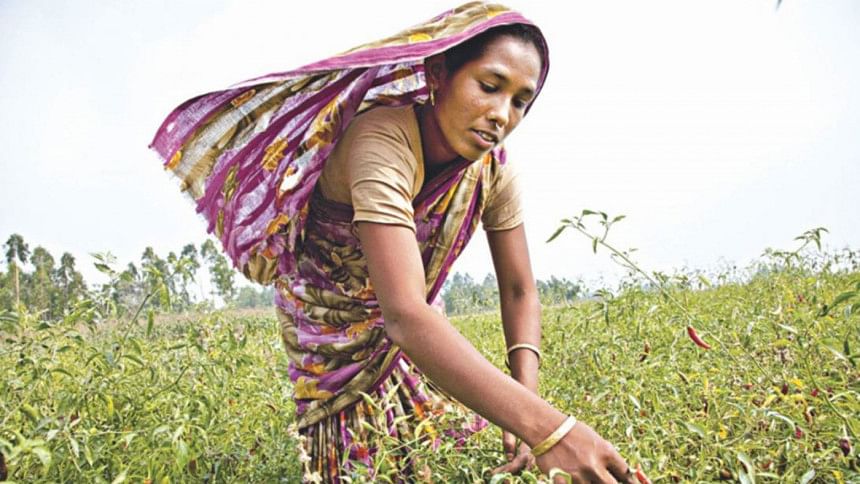Getting the best out of a changing rural economy

Rural Bangladesh is changing. This change has been happening rather fast during the last two decades. Rural activities are changing and the types of occupations are changing. So is the lifestyle of the rural population. This has been driven by income opportunities of a large number of rural population beyond agriculture. Hence the rural nonfarm sector has emerged as an important source of employment generation.
Over time, significant structural changes have taken place in the Bangladesh economy. During the last five decades the agriculture sector has been surpassed by industry and services sectors in terms of its contributions to the economy. Many developed countries have experienced similar structural transformation in their economies. Agriculture plays much less of an important role compared to the other sectors there. As a result, the sector is no more a major source of employment in those countries.
However, in Bangladesh more than 40 percent of the total labour force is still engaged in agriculture though the sector contributes only 13.65 percent to the gross domestic product (GDP) of Bangladesh as of 2019. This implies that there are surplus labour in the agriculture sector who are underemployed. On the other hand, employment in the manufacturing sector whose share in GDP is 35 percent, has not increased as expected but rather remained stagnant.
The Labour Force Survey and the Household Income and Expenditure Survey of the Bangladesh Bureau of Statistics indicate that in the fiscal year 2016-17, the share of rural nonfarm employment in total rural employment was 48 percent. This has increased from 37 percent in 2000. Rural people are engaged in several types of physical labour-based work such as self-employed cottage industries, handicrafts, wage-based employment in rural businesses, transport and construction work, repair, etc. There are also human capital-based professions which include monthly salaried employees in public and private offices, school and college teachers, lawyers, rural doctors, mid-wives, etc. Yet another type of work such as micro, small and medium businesses, contractors, shopkeepers, etc. require both financial and human capital.
Most villages in Bangladesh are now linked with the cities as economic needs have increased. Improved connectivity has facilitated this. This has changed the rural landscape too. New activities and services including tea stalls, coffee shops, restaurants, salons, beauty parlours, kindergarten schools, coaching centres, health clinics, diagnostic centres, photocopying, printing, cybercafé, communication, processing, and many other vocations are available in and within the periphery of the villages. This diversification also indicates the increased purchasing power in the rural areas. Moreover, this suggests that the quality of human resources and the entrepreneurship of rural people have improved now than before.
Limited land is an important push factor for the rural people to be engaged in the rural nonfarm sector. With large population and limited land, pressure on land is very high. The average farm size is also reducing. Besides, there is landlessness among many rural families. Hence for many, income opportunities from agriculture is shrinking. This has led the rural families to find activities beyond agriculture. Many have migrated to the cities in search of work and have been engaged in various informal activities. But not of all them can get a job. So, they try to find work in the rural non-agricultural sector.
Education among the new generation is another factor for rural people to move out of the agriculture sector. Many families have been able to increase agricultural productivity through the use of technology despite small land size. They invest this income on children's education so that their future generation can move towards human capital-based activities instead of labour based activities. So, children of agricultural families are making a transition from agriculture towards non-agriculture sector-based livelihoods.
Many initiatives have also facilitated the expansion of the rural nonfarm economy. First, programmes by both non-government and government organisations have helped nonfarm activities flourish. Organisations such as, Grameen Bank, Brac, Palli Karma Sahayak Foundation and similar ones have played important roles in helping the rural people with finance for their businesses.
Second, improved infrastructure had an important role to play in creating more employment opportunities in the nonfarm sector. Since the mid-eighties improved roads, culverts and bridges have increased the speed of lives by several times. So, the required time for completing activities has gone down. Besides, access to electricity has also made significant changes in the rural areas. Rural electrification has facilitated the creation of several new employment and income opportunities. People could work at night and shops could remain open at night due to electricity availability in the villages.
Third, remittances sent by non-resident Bangladeshi workers have been invested in the nonfarm activities. Remittances have also increased the purchasing power of rural people. Rural wages have gone up due to the inflow of remittances, though productivity has not increased by equal measure. Indeed, labour productivity in the agriculture sector is comparatively lower in Bangladesh than in many other countries. In addition to remittances, expansion of the manufacturing sector in the cities where migrated rural workers have been engaged has also pushed rural wages up. Export-oriented readymade garments sector is a major source of employment for the rural population, including women.
Fourth, access to technology has created new opportunities. Cable television, computer, mobile phone and internet have brought radical changes in the rural areas. Rural people can connect with the large cities and the world. They can access information on markets for their products, weather, jobs, healthcare facilities and much more through technology.
Much of the potentials for further transformation of the rural economy is still untapped. Through higher investment the sector can be further diversified and developed. During the ongoing Covid-19 pandemic reverse migration has been observed in Bangladesh. Many people who had earlier migrated to the cities have returned to villages as they lost their jobs and incomes. Ironically, large cities could not accommodate them, but they could somehow survive in the villages. Not only is the cost of living lower in the villages, they have a place to stay, and they have a social support mechanism.
The pandemic has reminded us of the importance of the rural economy. Also, the need for financial support to the small businesses has been felt more strongly. Most businesses in the rural areas are very small in size, and focused on services and trade. Many of them are not registered and rely on local markets only. Very few could expand their businesses outside their areas. Since many operate informally, they cannot take loans from the financial institutions. This has also been observed in case of the stimulus package for the small businesses announced by the government. Micro and small businesses do not have banking records which is discouraging banks to provide loans to them. However, if these businesses are not supported, many will not be able to survive. Therefore, special measures for disbursement of credit under the stimulus packages are needed. Besides, the role of the micro finance institutions in making the rural economy more dynamic and modern is also crucial.
A stronger and larger rural economy is crucial for employment generation and poverty reduction. This will in turn help reduce inequality and achieve sustainable development.
Dr Fahmida Khatun is the Executive Director at the Centre for Policy Dialogue.
Views expressed in this article are those of the author and do not necessarily reflect the position of her organisation.

 For all latest news, follow The Daily Star's Google News channel.
For all latest news, follow The Daily Star's Google News channel. 



Comments